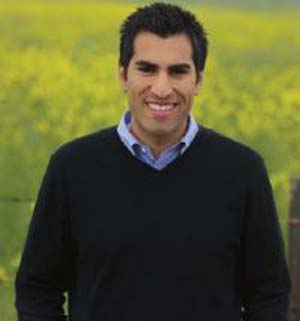While prominently emphasizing his experience as a firefighter in
a run for District 3 supervisor, candidate Robert Rivas during
stretches of the past two and a half years has gone out on fewer
responses than the number required in a Hollister Fire Department
policy for paid-call staff.
While prominently emphasizing his experience as a firefighter in a run for District 3 supervisor, candidate Robert Rivas during stretches of the past two and a half years has gone out on fewer responses than the number required in a Hollister Fire Department policy for paid-call staff.
A request for the documents regarding Rivas’ activity as a firefighter also showed that the city department doesn’t record its information in an electronic database to track whether paid-call firefighters are fulfilling the department’s mandated minimum.
Rivas, challenging Supervisor Pat Loe for the seat in the June primary, works full time as a senior clerk to the board in Monterey County. Since November 2007, he also has served on a paid-call basis for the Hollister Fire Department and he worked there full time for a month-long stretch in 2009.
With Rivas stressing his firefighter status in an array of campaign literature, the Free Lance requested records showing how many responses and hours he worked for the department.
According to one flier sent out last month: “My campaign is about bringing people together, just as I have done as a Hollister Firefighter, and something I will continue to do if elected to the Board of Supervisors.”
The first paragraph of his Facebook page, meanwhile, notes regarding his experience: “He’s a part-time firefighter and former aide to Assemblymember Simon Salinas. He has overseen numerous local measures that helped to create jobs and protect our rural character.”
If elected to the board, Rivas would continue to be a paid-call firefighter, he said.
“All my literature says what I am – I am a firefighter,” Rivas said.
Through April 15 of this year, Rivas had worked a total of 324 hours on paid calls and in training, documents show.
In total, including that month working full time, Rivas had worked 564 hours for the department over the two and a half years.
On non-mandated responses, excluding the month he worked full time filling in for a permanent firefighter on injury leave, the numbers average out to slightly less than one call per month, or about 45 minutes per month.
Of the available 111 calls for firefighters in his situation from January 2008 to November 2009 – the numbers made available by the fire department – Rivas attended 21 responses, which is slightly less than 19 percent.
Department policy requires that all paid-call firefighters attend 25 percent of responses, according to the fire chief.
Hollister Fire Chief Fred Cheshire noted how he does have the ability to waive the mandatory 25 percent if the firefighter has an adequate excuse such as working full time out of the county.
Rivas and others’ activity is broken down into calls for fires and medical responses. The numbers don’t include the month he spent as a temporary, full-time firefighter from October 11 of last year to the week of November 4. Over that time, Rivas worked 11 shifts as a full-time firefighter, according to the data. Rivas was offered the job after testing as one of the top paid-call firefighters, Cheshire said.
Department policy also states that during each quarter of a year, all paid-call firefighters must attend 75 percent of 15 hours worth of training exercises and must spend at least 36 hours responding to calls or training with other firefighters.
Training exercises include two, two-hour drills a month – and three more hours during a paid-call firefighter’s required 24-hour shift each quarter.
Rivas said his full-time job out of the county prevents him from responding to every call.
“There are a lot of calls that I’m just not available,” Rivas said. “But (the fire department) is fine with that.”
Each paid-call firefighter is given a pager that sends out a message when an emergency is reported. The pager’s service range doesn’t reach Monterey County, Rivas said.
Compared with two other firefighters with a similar schedule – a full-time job out of county – Rivas has responded to a similar number of calls. One of those other firefighters responded to 22 calls and another 18, Cheshire said. The department keeps 11 paid-call firefighters on staff. Among them, Rivas responded to the second-fewest number of calls during that time frame.
Rivas said he attends every training exercise. The attendance of the fire department’s paid-call firefighters during training exercises is the only attendance figure the department records electronically.
The department does not have a database that actively records the number of calls sent out and the number of responses a firefighter attends – instead it’s all recorded with hard copies, Cheshire confirmed.
“It’s something we are trying to do – to get everything electronic,” he said. “This is stuff we should be able to get quickly.”










